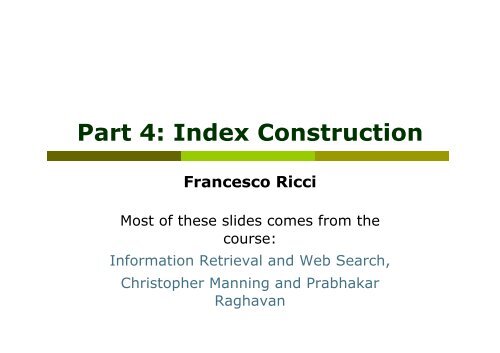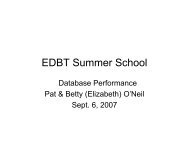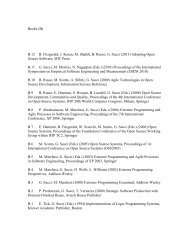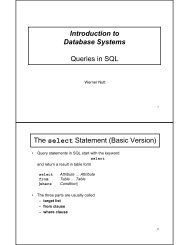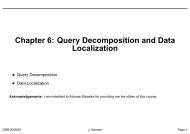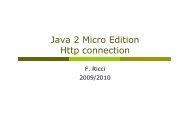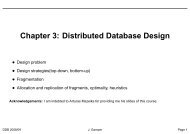Create successful ePaper yourself
Turn your PDF publications into a flip-book with our unique Google optimized e-Paper software.
<strong>Part</strong> 4: <strong>Index</strong> <strong>Construction</strong><br />
Francesco Ricci<br />
Most of these slides comes from the<br />
course:<br />
Information Retrieval and Web Search,<br />
Christopher Manning and Prabhakar<br />
Raghavan
Ch. 4<br />
<strong>Index</strong> construction<br />
How do we construct an index?<br />
What strategies can we use with limited main<br />
memory?
Sec. 4.1<br />
Hardware basics<br />
Many design decisions in information retrieval are<br />
based on the characteristics of hardware<br />
We begin by reviewing hardware basics
Hardware basics<br />
Sec. 4.1<br />
Access to data in memory is much faster than<br />
access to data on disk<br />
Disk seeks: No data is transferred from disk<br />
while the disk head is being positioned<br />
Therefore transferring one large chunk of data<br />
from disk to memory is faster than transferring<br />
many small chunks<br />
Disk I/O is block-based: Reading and writing of<br />
entire blocks (as opposed to smaller chunks)<br />
Block sizes: 8KB to 256 KB.<br />
Inside of Hard Drive video
Sec. 4.1<br />
Hardware basics<br />
Servers used in IR systems now typically have<br />
several GB of main memory, sometimes tens of<br />
GB<br />
Available disk space is several (2–3) orders of<br />
magnitude larger<br />
Fault tolerance is very expensive: It’s much<br />
cheaper to use many regular machines rather<br />
than one fault tolerant machine.
Google Web Farm<br />
The best guess is that Google now has more than<br />
450,000 servers (2 Petabytes of RAM 2*10 6<br />
Gigabytes)<br />
Spread over at least 25 locations around the world<br />
Connecting these centers is a high-capacity fiber optic<br />
network that the company has assembled over the<br />
last few years.<br />
J. Markoff, NYT, June<br />
2006<br />
Google is building two computing centers, top and left,<br />
each the size of a football field, in The Dalles, Ore.
Hardware assumptions<br />
Sec. 4.1<br />
symbol statistic value<br />
s average seek time 5 ms = 5 x 10 −3 s<br />
b transfer time per byte 0.02 μs = 2 x 10 −8 s<br />
processor’s clock rate 10 9 s −1<br />
p low-level operation 0.01 μs = 10 −8 s<br />
(e.g., compare & swap a word)<br />
size of main memory several GB<br />
size of disk space 1 TB or more<br />
<br />
Example: Reading 1GB from disk<br />
• If stored in contiguous blocks: 2 x 10 −8 s x 10 9 = 20s<br />
• If stored in 1M chunks of 1KB: 20s + 10 6 x 5 x 10 −3 s =<br />
5020 s = 1.4 h
A Reuters RCV1 document<br />
Sec. 4.2
Reuters RCV1 statistics<br />
Sec. 4.2<br />
symbol statistic value<br />
N documents 800,000<br />
L avg. # tokens per doc 200<br />
M terms (= word types) 400,000<br />
avg. # bytes per token 6<br />
(incl. spaces/punct.)<br />
avg. # bytes per token 4.5<br />
(without spaces/punct.)<br />
avg. # bytes per term 7.5<br />
T non-positional postings 100,000,000<br />
•4.5 bytes per word token vs. 7.5 bytes per word type: why?<br />
•Why T \= N*L?
Recall IIR 1 index construction<br />
<br />
Documents are parsed to extract words and<br />
these are saved with the Document ID.<br />
Doc 1<br />
I did enact Julius<br />
Caesar I was killed<br />
i' the Capitol;<br />
Brutus killed me.<br />
Doc 2<br />
So let it be with<br />
Caesar. The noble<br />
Brutus hath told you<br />
Caesar was<br />
ambitious<br />
Sec. 4.2<br />
Term Doc #<br />
I 1<br />
did 1<br />
enact 1<br />
julius 1<br />
caesar 1<br />
I 1<br />
was 1<br />
killed 1<br />
i' 1<br />
the 1<br />
capitol 1<br />
brutus 1<br />
killed 1<br />
me 1<br />
so 2<br />
let 2<br />
it 2<br />
be 2<br />
with 2<br />
caesar 2<br />
the 2<br />
noble 2<br />
brutus 2<br />
hath 2<br />
told 2<br />
you 2<br />
caesar 2<br />
was 2<br />
ambitious 2
Key step<br />
<br />
After all documents have<br />
been parsed, the inverted<br />
file is sorted by terms.<br />
We focus on this sort step.<br />
We have 100M items to sort<br />
for Reuters RCV1<br />
Term Doc #<br />
I 1<br />
did 1<br />
enact 1<br />
julius 1<br />
caesar 1<br />
I 1<br />
was 1<br />
killed 1<br />
i' 1<br />
the 1<br />
capitol 1<br />
brutus 1<br />
killed 1<br />
me 1<br />
so 2<br />
let 2<br />
it 2<br />
be 2<br />
with 2<br />
caesar 2<br />
the 2<br />
noble 2<br />
brutus 2<br />
hath 2<br />
told 2<br />
you 2<br />
caesar 2<br />
was 2<br />
ambitious 2<br />
Sec. 4.2<br />
Term Doc #<br />
ambitious 2<br />
be 2<br />
brutus 1<br />
brutus 2<br />
capitol 1<br />
caesar 1<br />
caesar 2<br />
caesar 2<br />
did 1<br />
enact 1<br />
hath 1<br />
I 1<br />
I 1<br />
i' 1<br />
it 2<br />
julius 1<br />
killed 1<br />
killed 1<br />
let 2<br />
me 1<br />
noble 2<br />
so 2<br />
the 1<br />
the 2<br />
told 2<br />
you 2<br />
was 1<br />
was 2<br />
with 2
Scaling index construction<br />
Sec. 4.2<br />
In-memory index construction does not scale<br />
How can we construct an index for very large<br />
collections?<br />
Taking into account the hardware constraints we<br />
just learned about . . .<br />
Memory, disk, speed, etc.
Sort-based index construction<br />
Sec. 4.2<br />
As we build the index, we parse docs one at a time<br />
• While building the index, we cannot easily exploit<br />
compression tricks (you can, but much more<br />
complex)<br />
The final postings for any term are incomplete until<br />
the end<br />
At 12 bytes per non-positional postings entry (term,<br />
doc, freq), demands a lot of space for large collections<br />
T = 100,000,000 in the case of RCV1 – so 1.2GB<br />
• So … we can do this in memory in 2009, but typical<br />
collections are much larger - e.g. the New York<br />
Times provides an index of >150 years of newswire<br />
Thus: We need to store intermediate results on disk.
Use the same algorithm for disk?<br />
Sec. 4.2<br />
Can we use the same index construction<br />
algorithm for larger collections, but by using disk<br />
instead of memory?<br />
• I.e. scan the documents, and for each token<br />
write the corresponding posting (term, doc,<br />
freq) on a new file<br />
• Finally sort the postings and build the postings<br />
lists for all the terms<br />
No: Sorting T = 100,000,000 records (term, doc,<br />
freq) on disk is too slow – too many disk seeks<br />
• See next slide<br />
We need an external sorting algorithm.
Bottleneck<br />
Sec. 4.2<br />
Parse and build postings entries one doc at a<br />
time<br />
Now sort postings entries by term (then by doc<br />
within each term)<br />
Doing this with random disk seeks would be too<br />
slow – must sort T = 100M records<br />
If every comparison took 2 disk seeks, and N items could be<br />
sorted with N log 2 N comparisons, how long would this take?<br />
2*ds*Nlog 2 N s= 2*5*10 -3 * 10 8 log 2 10 8 = 10 6 *<br />
log 2 10 8 = 10 6 * 26,5 = 2,65 * 10 7 s = 307 days!<br />
What can we do?
BSBI: Blocked sort-based <strong>Index</strong>ing<br />
(Sorting with fewer disk seeks)<br />
12-byte (4+4+4) records (term, doc, freq)<br />
These are generated as we parse docs<br />
Must now sort 100M such 12-byte records by<br />
term<br />
Define a Block ~ 10M such records<br />
• Can easily fit a couple into memory<br />
• Will have 10 such blocks to start with (RCV1)<br />
Basic idea of algorithm:<br />
• Accumulate postings for each block, sort, write<br />
to disk<br />
• Then merge the blocks into one long sorted<br />
order.<br />
Sec. 4.2
Blocks<br />
consider<br />
different<br />
documents<br />
Sec. 4.2
Sorting 10 blocks of 10M records<br />
Sec. 4.2<br />
First, read each block and sort (in memory)<br />
within:<br />
• Quicksort takes 2N ln N expected steps<br />
• In our case 2 x (10M ln 10M) steps<br />
Exercise: estimate total time to read each block<br />
from disk and quicksort it<br />
10 times this estimate – gives us 10 sorted runs<br />
of 10M records each<br />
Done straightforwardly, need 2 copies of data on<br />
disk<br />
• But can optimize this
Block sorted-based indexing<br />
Sec. 4.2<br />
Keeping the<br />
dictionary in memory<br />
n = number of<br />
generated blocks
How to merge the sorted runs?<br />
Sec. 4.2<br />
Open all block files and maintain small read<br />
buffers - and a write buffer for the final merged<br />
index<br />
In each iteration select the lowest termID that<br />
has not been processed yet<br />
All postings lists for this termID are read and<br />
merged, and the merged list is written back to disk<br />
Each read buffer is refilled from its file when<br />
necessary<br />
Providing you read decent-sized chunks of each<br />
block into memory and then write out a decentsized<br />
output chunk, then you’re not killed by disk<br />
seeks.
Remaining problem with sort-based<br />
algorithm<br />
Sec. 4.3<br />
Our assumption was: we can keep the dictionary<br />
in memory<br />
We need the dictionary (which grows<br />
dynamically) in order to implement a term to<br />
termID mapping<br />
Actually, we could work with (term, docID)<br />
postings instead of (termID, docID) postings . . .<br />
. . . but then intermediate files become larger -<br />
we would end up with a scalable, but slower<br />
index construction method.<br />
Why?
SPIMI:<br />
Single-pass in-memory indexing<br />
Sec. 4.3<br />
Key idea 1: Generate separate dictionaries for<br />
each block – no need to maintain term-termID<br />
mapping across blocks<br />
Key idea 2: Don’t sort the postings - accumulate<br />
postings in postings lists as they occur<br />
With these two ideas we can generate a complete<br />
inverted index for each block<br />
These separate indexes can then be merged into<br />
one big index.
SPIMI-Invert<br />
Sec. 4.3<br />
When the memory has been exhausted -<br />
write the index of the block (dictionary,<br />
postings lists) to disk<br />
Then merging of blocks is analogous to<br />
BSBI (plus dictionary merging).
SPIMI: Compression<br />
Sec. 4.3<br />
Compression makes SPIMI even more efficient.<br />
• Compression of terms<br />
• Compression of postings<br />
See next – (optional)
Distributed indexing<br />
Sec. 4.4<br />
For web-scale indexing (don’t try this at home!):<br />
must use a distributed computing cluster<br />
Individual machines are fault-prone<br />
• Can unpredictably slow down or fail<br />
How do we exploit such a pool of machines?
Google data centers<br />
Sec. 4.4<br />
Google data centers mainly contain commodity<br />
machines<br />
Data centers are distributed around the world<br />
Estimate: a total of 1 million servers, 3 million<br />
processors/cores (Gartner 2007)<br />
Estimate: Google installs 100,000 servers each<br />
quarter<br />
• Based on expenditures of 200–250 million<br />
dollars per year<br />
This would be 10% of the computing capacity of<br />
the world!?!
Google data centers<br />
If in a non-fault-tolerant system with 1000<br />
nodes, each node has 99.9% uptime, what is the<br />
uptime of the system?<br />
• All of them should be simultaneously up<br />
Answer: 37%<br />
• (p of staying up) # of server = (0.999) 1000<br />
Calculate the number of servers failing per<br />
minute for an installation of 1 million servers.
Distributed indexing<br />
Sec. 4.4<br />
Maintain a master machine directing the<br />
indexing job – considered “safe”<br />
Break up indexing into sets of (parallel) tasks<br />
Master machine assigns each task to an idle<br />
machine from a pool.
Parallel tasks<br />
Sec. 4.4<br />
We will use two sets of parallel tasks<br />
• Parsers<br />
• Inverters<br />
Break the input document collection into splits<br />
Document collection<br />
split split split split split<br />
Each split is a subset of documents<br />
(corresponding to blocks in BSBI/SPIMI)
Parsers<br />
Sec. 4.4<br />
Master assigns a split to an idle parser machine<br />
Parser reads a document at a time and emits<br />
(term, doc) pairs<br />
Parser writes pairs into j partitions<br />
Each partition is for a range of terms’ first letters<br />
• (e.g., a-f, g-p, q-z) – here j = 3.<br />
Now to complete the index inversion …<br />
split parser a-f g-p q-z<br />
3 partitions
Inverters<br />
Sec. 4.4<br />
An inverter collects all (term,doc) pairs (=<br />
postings) for one term-partition<br />
Sorts and writes to postings lists.<br />
a-f<br />
a-f<br />
inverter<br />
a-f<br />
postings<br />
...<br />
a-f
Data flow: MapReduce<br />
Sec. 4.4<br />
assign<br />
Master<br />
assign<br />
Postings<br />
Parser<br />
a-f g-p q-z<br />
Inverter<br />
a-f<br />
Parser<br />
a-f g-p q-z<br />
Inverter<br />
g-p<br />
splits<br />
Parser<br />
a-f g-p q-z<br />
Inverter<br />
q-z<br />
Map<br />
phase<br />
Segment files<br />
Reduce<br />
phase
MapReduce<br />
Sec. 4.4<br />
The index construction algorithm we just described is<br />
an instance of MapReduce<br />
MapReduce (Dean and Ghemawat 2004) is a robust<br />
and conceptually simple framework for distributed<br />
computing …<br />
• … without having to write code for the distribution<br />
part<br />
Solve large computing problems on cheap commodity<br />
machines or nodes that are built from standard parts<br />
(processor, memory, disk) as opposed to on a<br />
supercomputer with specialized hardware<br />
They describe the Google indexing system (ca. 2002)<br />
as consisting of a number of phases, each<br />
implemented in MapReduce.
MapReduce<br />
Sec. 4.4<br />
<strong>Index</strong> construction was just one phase<br />
Another phase (not shown here): transforming a<br />
term-partitioned index into a documentpartitioned<br />
index<br />
• Term-partitioned: one machine handles a<br />
subrange of terms<br />
• Document-partitioned: one machine handles a<br />
subrange of documents<br />
As we will discuss in the web part of the course -<br />
most search engines use a documentpartitioned<br />
index … better load balancing, etc.
Schema for index construction in<br />
MapReduce<br />
Sec. 4.4<br />
<br />
<br />
<br />
<br />
<br />
<br />
<br />
<br />
Schema of map and reduce functions<br />
map: input → list(k, v) reduce: (k,list(v)) → output<br />
Instantiation of the schema for index construction<br />
map: web collection → list(termID, docID)<br />
reduce: (, ,<br />
…) → (postings list1, postings list2, …)<br />
Example for index construction<br />
map: (d2 : "C died.", d1 : "C came, C c’ed.") → (,<br />
, , , , <br />
reduce: (, , ,<br />
) → (, ,<br />
, )
Dynamic indexing<br />
Sec. 4.5<br />
Up to now, we have assumed that collections are<br />
static<br />
They rarely are:<br />
• Documents come in over time and need to be<br />
inserted<br />
• Documents are deleted and modified<br />
This means that the dictionary and postings<br />
lists have to be modified:<br />
• Postings updates for terms already in<br />
dictionary<br />
• New terms added to dictionary.
Simplest approach<br />
Sec. 4.5<br />
Maintain big main index<br />
New docs go into small auxiliary index<br />
Search across both, merge results<br />
Deletions<br />
• Invalidation bit-vector for deleted docs<br />
• Filter docs output on a search result by this<br />
invalidation bit-vector<br />
Periodically, re-index into one main index.
Sec. 4.5<br />
Issues with main and auxiliary indexes<br />
Problem of frequent merges – you touch stuff a lot<br />
Poor performance during merge<br />
Actually:<br />
• Merging of the auxiliary index into the main index<br />
is efficient if we keep a separate file for each<br />
postings list<br />
• Merge is the same as a simple append<br />
• But then we would need a lot of files – inefficient<br />
for O/S<br />
Assumption for the rest of the lecture: The index is<br />
one big file<br />
In reality: use a scheme somewhere in between (e.g.,<br />
split very large postings lists, collect postings lists of<br />
length 1 in one file etc.).
Sec. 4.5<br />
Logarithmic merge<br />
Maintain a series of indexes, each twice as large<br />
as the previous one<br />
Keep smallest (Z 0 ) in memory<br />
Larger ones (I 0 , I 1 , …) on disk<br />
If Z 0 gets too big (> n), write to disk as I 0<br />
or merge with I 0 (if I 0 already exists) as Z 1<br />
Either write merge Z 1 to disk as I 1 (if no I 1 )<br />
Or merge with I 1 to form Z 2<br />
etc.
Sec. 4.5
Logarithmic merge<br />
Sec. 4.5<br />
Auxiliary and main index: index construction<br />
time is O(T 2 ) as each posting is touched in each<br />
merge<br />
Logarithmic merge: Each posting is merged<br />
O(log T) times, so complexity is O(T log T)<br />
So logarithmic merge is much more efficient for<br />
index construction<br />
But query processing now requires the merging<br />
of O(log T) indexes<br />
• Whereas it is O(1) if you just have a main and<br />
auxiliary index
Further issues with multiple indexes<br />
Sec. 4.5<br />
Collection-wide statistics are hard to maintain<br />
E.g., when we spoke of spell-correction: which of<br />
several corrected alternatives do we present to<br />
the user?<br />
• We said, pick the one with the most hits<br />
How do we maintain the top ones with multiple<br />
indexes and invalidation bit vectors?<br />
• One possibility: ignore everything but the main<br />
index for such ordering<br />
Will see more such statistics used in results<br />
ranking.
Dynamic indexing at search engines<br />
Sec. 4.5<br />
All the large search engines now do dynamic<br />
indexing<br />
Their indices have frequent incremental changes<br />
• News items, blogs, new topical web pages<br />
Sarah Palin, …<br />
But (sometimes/typically) they also periodically<br />
reconstruct the index from scratch<br />
• Query processing is then switched to the new<br />
index, and the old index is then deleted
Google trends
Other sorts of indexes<br />
Sec. 4.5<br />
<br />
<br />
Positional indexes<br />
• Same sort of sorting problem … just larger<br />
Building character n-gram indexes:<br />
• As text is parsed, enumerate n-grams<br />
• For each n-gram, need pointers to all dictionary terms<br />
containing it – the “postings”<br />
• Note that the same “postings entry” will arise repeatedly<br />
in parsing the docs – need efficient hashing to keep<br />
track of this<br />
E.g., that the trigram uou occurs in the term<br />
deciduous will be discovered on each text<br />
occurrence of deciduous<br />
Only need to process each term once.<br />
Why?
Reading Material<br />
Sections: Chapter 4 IIR


